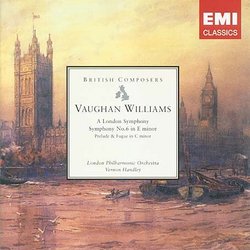| All Artists: Vernon Handley Title: Williams: A London Symphony Members Wishing: 0 Total Copies: 0 Label: Emi Uk/Zoom Release Date: 1/6/2009 Album Type: Import Genre: Classical Style: Number of Discs: 2 SwapaCD Credits: 2 UPCs: 724358659221, 724358659221 |
Search - Vernon Handley :: Williams: A London Symphony
CD Details |
CD ReviewsA superb "London Symphony" to vie with the best Santa Fe Listener | Santa Fe, NM USA | 06/06/2010 (5 out of 5 stars) "The late and well loved Vernon "Tod" Handley was a mainstay of British music who has around 140 CDs in print, but he kept his light under a bushel basket in Liverpool, rarely if ever appearing in the U.S. With his own royal Liverpool orchestra Handley released a super-bargain cycle of the Vaughan Williams symphonies whose high musical qualities belie the price. Quite a few performances are close to being first choices. Here, however, he takes a holiday with the London Phil., and the introduction of a superior orchestra makes a great difference. Even at its high price on the used market, this is one of the choice recordings in the RVW canon. The original recordings appeared on LP in 1978 and 1980.
Handle's account of Symphony #2, a favorite with British listeners, is immediately attractive for his urgent, vivid interpretation, aided by sharp, close-up microphone placement -- the performance jumps out of the speakers. The work's four movements portray London in different moods, places, and times, but with a prevailing nostalgia that almost every critic labels Dickensian. But RVW had contemporary London in mind, with such settings as Westminster at dawn, the Strand at noon, Bloomsbury Sq. in November, and the mouth of the Thames at night where it opens to the sea. Like the Sea Symphony that preceded it, "A London Symphony" is long at over 46 min. and panoramic (it was even longer in its original 1914 version, which the composer later trimmed; he continued his revisions until 1934). For a plush, less aggressive reading there is Previn and the LSO; for the complete original score there is Richard Hickox and the same LSO on Chandos. But for those of us outside the UK, one "London Sym." may be enough, and Handle's ebullience is infectious, even if the loudest, highest passages reveal some edginess in the sound. Vaughan williams veered into dissonant modernism with two symphonies, the Fourth and Sixth, that he insisted contained no program, but hidden political inferences abound -- the Fourth emerged from the despairing Thirites and RVS's reaction to World War I, the Sixth appeared in 1948 and seemed to audiences at the time to evoke the Blitz and, in its eerie pianissimo finale, the nightmarish prospect of a dead post-nuclear landscape. Taking their cue from those hints, many conductors play the Sixth for crushing grimness, but Handley, preferring to view it as pure music, lifts the tempo and makes the syncopated first movement assertively jaunty. the Morse code staccato rhythm of the second movement cant help but sound eerie, like blips on a sonar screen, but Handley isn't as threatening as some; he veils the menace by being direct and fairly brisk. The riddle of the Scherzo has always enticed commentators. Some hear in it a rollicking West End in wartime; this movement is said to memorialize a popular saxophonist, a friend of the composer's, who was killed by bombing in the Blitz. Certainly the saxophone solos can be played for eerie melancholy -- Handley doesn't bring out that aspect. His reading is fast and furious enough to hint at desperation, however. The finale, which RVW called an Epilogue, is meant to be pianissimo throughout and executed "without expression." Audiences find the slow fugal structure hard to focus on, and Handley makes it somewhat easier by increasing the pace and ignoring the instruction to remain very soft.As you can see, tis is a Sixth that goes its own way. On its own terms, it is successful if not on a par with the Sym. #2. The twofer is filled out with a brief orchestration that RVW made of an organ solo from 1921, following Bach's model of a Prelude and Fugure (he and Stokowski shared the same organ teacher in music school, although the future conductor was a decade younger). The work is only ten minutes long but exhibits more than a hint of the abrasive turbulence that would appear full blown in the Fourth Sym." |

